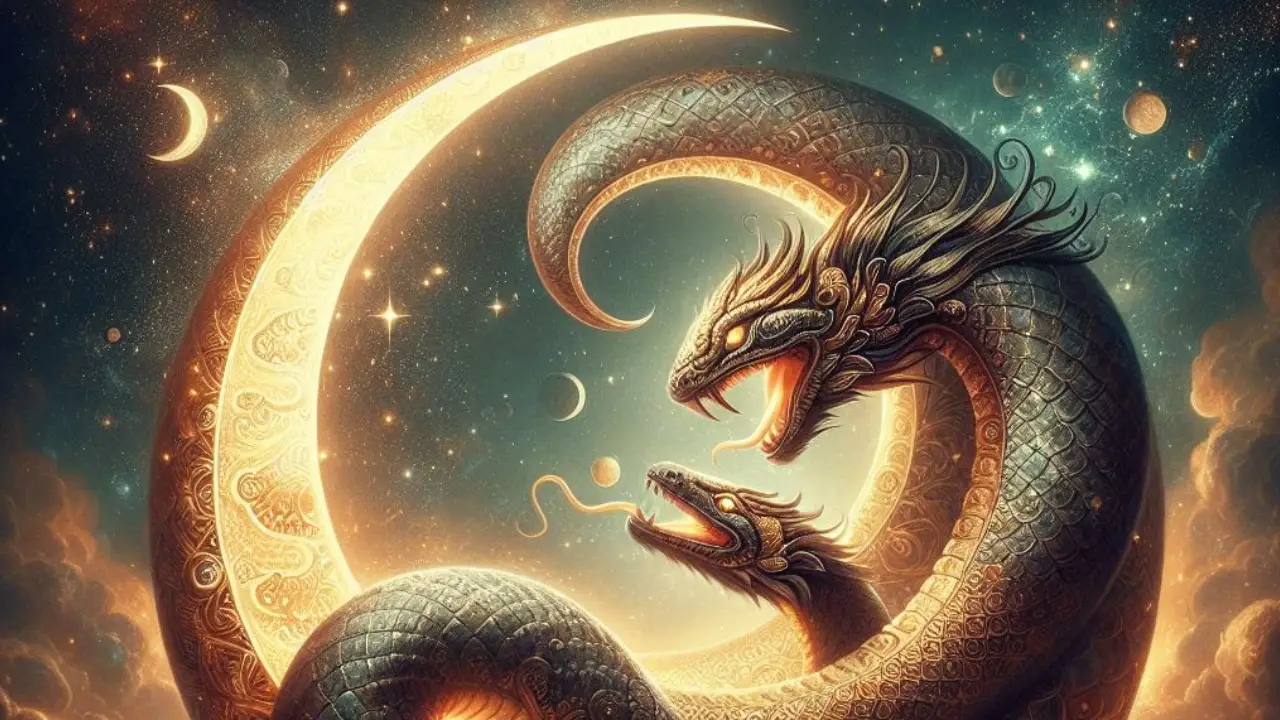The eerie shadows cast during a solar or lunar eclipse have long fueled the imagination of humanity. But in Hindu mythology, these celestial phenomena have deeper significance, woven into the fabric of ancient lore. Let’s delve into the captivating tale of Rahu and Ketu. They are the demon duo believed to swallow the sun and moon, shaping cosmic destinies.
Origins of Rahu and Ketu
According to Hindu mythology, during the time when the Devas (celestial beings) and Asuras (demons) churned the cosmic ocean to obtain the elixir of immortality, Lord Vishnu took the form of a celestial maiden named Mohini. Entranced by her beauty, the Asura Swarbhanu managed to sneak into the line of Devas partaking in the elixir. However, before Mohini could thwart him, Swarbhanu consumed a few drops of the elixir, attaining immortality.
Angered by this deceit, the sun and moon deities, Surya and Chandra, alerted Lord Vishnu, who promptly beheaded Swarbhanu. But as he had already sipped the elixir, his head (Rahu) and body (Ketu) became immortal entities, forever seeking revenge by swallowing the sun and moon during eclipses.
Significance in Hindu Cosmology
In Hindu cosmology, Rahu and Ketu are known as the lunar nodes. These are points where the paths of the sun and the moon intersect. Astrologically, they hold immense significance, symbolizing the karmic forces that influence human destiny.
Rahu influences desires, ambitions, and worldly pursuits, bringing sudden changes, obsessions, and material gains, often guiding individuals towards their destinies through unconventional paths.
On the other hand, Ketu, symbolizing the body without a head, signifies detachment, spirituality, and enlightenment. Its influence is considered more introspective, leading individuals towards self-realization, renunciation, and liberation from worldly attachments.
Mythical Interpretations and Symbolism
The myth of Rahu and Ketu holds profound allegorical meanings beyond its celestial spectacle. It symbolizes the eternal struggle between light and darkness, good and evil, and the cyclical nature of cosmic order.
Rahu’s insatiable desire to consume the sun and moon mirrors the human thirst for power, fame, and material wealth. Conversely, Ketu’s detached nature signifies the importance of letting go, surrendering to higher truths, and embracing spiritual growth.
The Cosmic Balance: Yin and Yang of Hindu Cosmology
In Hindu philosophy, the concept of duality is pervasive, symbolized by contrasting forces such as creation and destruction, order and chaos, and growth and decay. Rahu and Ketu epitomize this cosmic balance, representing opposing yet complementary aspects of the universe.
Rahu, with its voracious appetite for worldly pleasures, symbolizes the materialistic pursuits that often entangle individuals in the web of desires and illusions. Its influence prompts us to confront our earthly attachments and navigate the challenges of the material world with discernment and wisdom.
Conversely, Ketu embodies the path of renunciation and spiritual transcendence. It urges us to detach from the transient and ephemeral aspects of existence. Its influence encourages introspection, self-awareness, and the pursuit of higher truths beyond the confines of material reality.
Astrological Implications: Navigating the Karmic Pathways
In Vedic astrology, the positions of Rahu and Ketu in one’s birth chart are believed to hold profound implications. It can affect one’s karmic journey and spiritual evolution. Known as the North and South Lunar Nodes respectively, they signify the karmic axis along which the soul traverses across lifetimes, seeking enlightenment and liberation.
Rahu’s placement in a particular house or sign often indicates areas of life where one may experience intense desires, challenges, and opportunities for growth. Its influence can propel individuals towards ambitious pursuits, worldly success, and transformative experiences, albeit with potential pitfalls and obstacles along the way.
Ketu’s placement emphasizes areas of life where detachment, introspection, and spiritual growth come to the forefront. Its influence may manifest as a sense of disillusionment with worldly pursuits, a yearning for solitude and introspection, or a deep longing for spiritual fulfillment beyond mundane concerns.
Mythological Parallels: Archetypal Motifs in Global Folklore
The myth of Rahu and Ketu resonates with similar archetypal motifs found in mythologies and folklore across cultures. From the Greek legend of the Hydra to the Chinese tale of the Dragon-Eating Sun, stories of celestial beings devouring cosmic entities abound. This reflects humanity’s fascination with celestial phenomena and the eternal struggle between cosmic forces.
These parallels underscore the universality of human experiences and the timeless quest for meaning, transcendence, and cosmic harmony. By exploring the myth of Rahu and Ketu through a comparative lens, we gain deeper insights into the archetypal patterns that shape our collective consciousness and cultural narratives.
Rituals and Remedies: Appeasing the Celestial Forces
In Hindu tradition, practitioners prescribe various rituals and remedies to mitigate the malefic effects of Rahu and Ketu and harness their beneficial energies. These include the recitation of sacred mantras to the performance of elaborate yagyas (fire ceremonies) and more. Devotees seek divine intervention to appease these celestial forces and align themselves with the cosmic order.
Additionally, gemstone therapy, astrological consultations, and charitable acts are often recommended. They are used as means of propitiating Rahu and Ketu and balancing their cosmic influences. Whether through traditional rituals or modern practices, the goal remains the same. It is to harmonize one’s karmic pathways and attain spiritual equilibrium.
Embracing Cosmic Harmony
The myth of Rahu and Ketu transcends mere astronomical phenomena. It offers profound insights into the human condition and the interconnectedness of the cosmos. By understanding and embracing these celestial forces, we can navigate the complexities of life with greater wisdom, humility, and spiritual insight.
As the shadows of Rahu and Ketu converge during eclipses, let us remember the eternal dance of light and darkness. And to strive to find harmony within ourselves and the universe.
What are your thoughts on the myth of Rahu and Ketu? Share your insights and experiences in the comments below!

